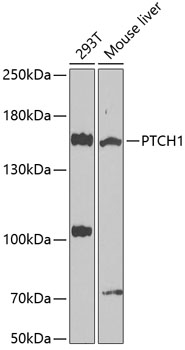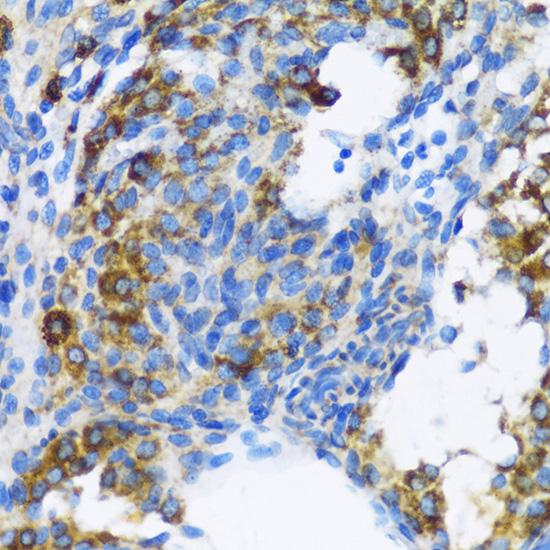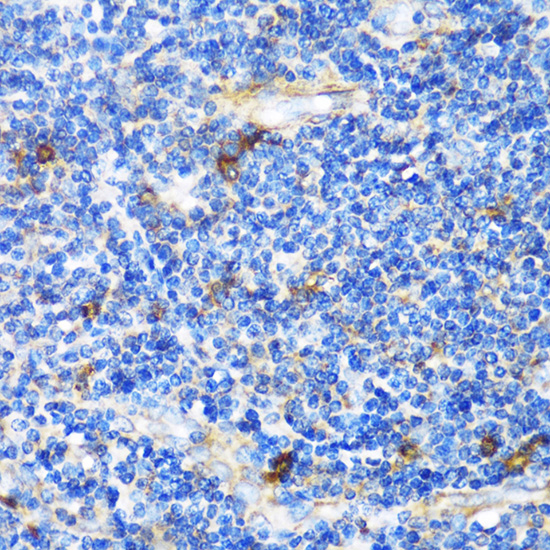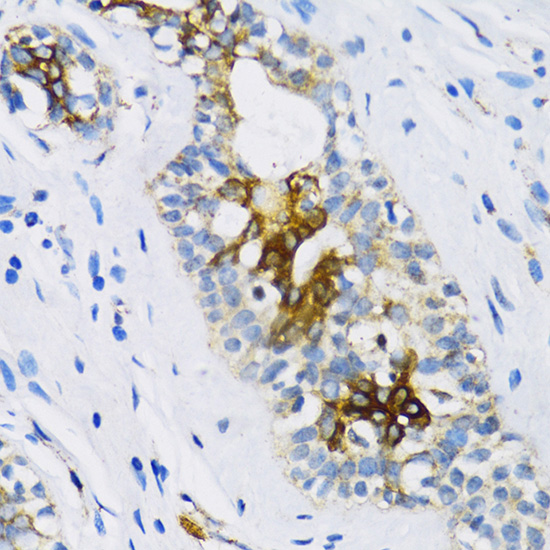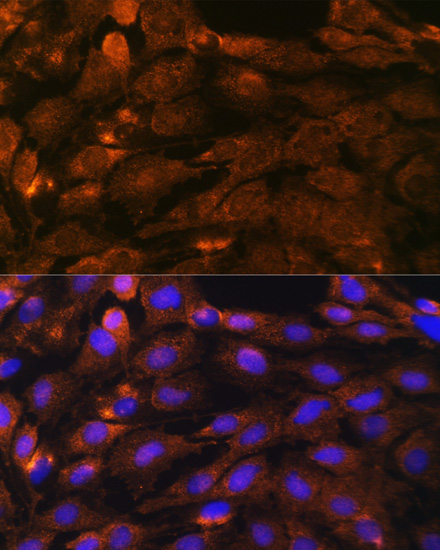Cell Biology Antibodies 1
Anti-PTCH1 Antibody (CAB0826)
- SKU:
- CAB0826
- Product Type:
- Antibody
- Reactivity:
- Human
- Reactivity:
- Mouse
- Reactivity:
- Rat
- Host Species:
- Rabbit
- Isotype:
- IgG
- Antibody Type:
- Polyclonal Antibody
- Research Area:
- Cell Biology
Description
| Antibody Name: | Anti-PTCH1 Antibody |
| Antibody SKU: | CAB0826 |
| Antibody Size: | 20uL, 50uL, 100uL |
| Application: | WB IHC IF |
| Reactivity: | Human, Mouse, Rat |
| Host Species: | Rabbit |
| Immunogen: | Recombinant fusion protein containing a sequence corresponding to amino acids 1214-1312 of human PTCH1 (NP_000255.2). |
| Application: | WB IHC IF |
| Recommended Dilution: | WB 1:500 - 1:1000 IHC 1:50 - 1:100 IF 1:50 - 1:100 |
| Reactivity: | Human, Mouse, Rat |
| Positive Samples: | 293T, Mouse liver |
| Immunogen: | Recombinant fusion protein containing a sequence corresponding to amino acids 1214-1312 of human PTCH1 (NP_000255.2). |
| Purification Method: | Affinity purification |
| Storage Buffer: | Store at -20'C. Avoid freeze / thaw cycles. Buffer: PBS with 0.02% sodium azide, 50% glycerol, pH7.3. |
| Isotype: | IgG |
| Sequence: | THSG SDSS DSEY SSQT TVSG LSEE LRHY EAQQ GAGG PAHQ VIVE ATEN PVFA HSTV VHPE SRHH PPSN PRQQ PHLD SGSL PPGR QGQQ PRRD PPRE GLW |
| Gene ID: | 5727 |
| Uniprot: | Q13635 |
| Cellular Location: | Membrane, Multi-pass membrane protein |
| Calculated MW: | 144kDa/153kDa/160kDa/161kDa |
| Observed MW: | 160kDa |
| Synonyms: | PTCH1, BCNS, HPE7, NBCCS, PTC, PTC1, PTCH, PTCH11, patched 1 |
| Background: | This gene encodes a member of the patched gene family. The encoded protein is the receptor for sonic hedgehog, a secreted molecule implicated in the formation of embryonic structures and in tumorigenesis, as well as the desert hedgehog and indian hedgehog proteins. This gene functions as a tumor suppressor. Mutations of this gene have been associated with basal cell nevus syndrome, esophageal squamous cell carcinoma, trichoepitheliomas, transitional cell carcinomas of the bladder, as well as holoprosencephaly. Alternative splicing results in multiple transcript variants encoding different isoforms. Additional splice variants have been described, but their full length sequences and biological validity cannot be determined currently. |
| UniProt Protein Function: | PTCH1: a multi-pass membrane protein member of the ?patched? family that acts as a receptor for sonic hedgehog (SHH), indian hedgehog (IHH) and desert hedgehog (DHH). Associates with the smoothened protein (SMO) to transduce the hedgehog protein?s signal. Seems to have a tumor suppressor function, as inactivation of this protein is probably a necessary, if not sufficient step for tumorigenesis. Interacts with SNX17. Expressed in tumor cells but not in normal skin. In the embryo, found in all major target tissues of sonic hedgehog, such as the ventral neural tube, somites, and tissues surrounding the zone of polarizing activity of the limb bud. Defects in PTCH1 are the cause of basal cell nevus syndrome (BCNS), also known as Gorlin syndrome. BCNS is an autosomal dominant disease characterized by nevoid basal cell carcinomas and developmental abnormalities such as rib and craniofacial alterations, polydactyly, syndactyly, and spina bifida. In addition, the patients suffer from a multitude of tumors like basal cell carcinomas, fibromas of the ovaries and heart, cysts of the skin, jaws and mesentery, as well as medulloblastomas and meningiomas. PTCH1 defects is also the cause of holoprosencephaly, the most common structural anomaly of the brain, in which the developing forebrain fails to correctly separate into right and left hemispheres. |
| UniProt Protein Details: | Protein type:Cell cycle regulation; Tumor suppressor; Membrane protein, integral; Membrane protein, multi-pass Chromosomal Location of Human Ortholog: 9q22.3 Cellular Component: Golgi apparatus; intracellular membrane-bound organelle; perinuclear region of cytoplasm; postsynaptic density; integral to membrane; plasma membrane; caveola; midbody Molecular Function:heparin binding; cyclin binding; protein binding; hedgehog receptor activity; cholesterol binding; protein complex binding; patched binding; smoothened binding Biological Process: heart morphogenesis; hindlimb morphogenesis; epidermis development; regulation of mitotic cell cycle; negative regulation of transcription from RNA polymerase II promoter; glucose homeostasis; response to estradiol stimulus; response to chlorate; regulation of protein localization; negative regulation of osteoblast differentiation; negative regulation of epithelial cell proliferation; embryonic limb morphogenesis; response to drug; smoothened signaling pathway; response to retinoic acid; negative regulation of multicellular organism growth; pharyngeal system development; in utero embryonic development; negative regulation of transcription factor activity; neural tube patterning; negative regulation of cell division; keratinocyte proliferation; spinal cord motor neuron differentiation; limb morphogenesis; organ morphogenesis; dorsal/ventral pattern formation; response to mechanical stimulus; ureteric bud branching; negative regulation of smoothened signaling pathway; neural plate pattern formation; neural tube closure; embryonic organ development; protein processing; brain development; regulation of smoothened signaling pathway Disease: Holoprosencephaly 7; Basal Cell Nevus Syndrome; Basal Cell Carcinoma, Susceptibility To, 1 |
| NCBI Summary: | This gene encodes a member of the patched family of proteins and a component of the hedgehog signaling pathway. Hedgehog signaling is important in embryonic development and tumorigenesis. The encoded protein is the receptor for the secreted hedgehog ligands, which include sonic hedgehog, indian hedgehog and desert hedgehog. Following binding by one of the hedgehog ligands, the encoded protein is trafficked away from the primary cilium, relieving inhibition of the G-protein-coupled receptor smoothened, which results in activation of downstream signaling. Mutations of this gene have been associated with basal cell nevus syndrome and holoprosencephaly. [provided by RefSeq, Aug 2017] |
| UniProt Code: | Q13635 |
| NCBI GenInfo Identifier: | 134254446 |
| NCBI Gene ID: | 5727 |
| NCBI Accession: | NP_000255.2 |
| UniProt Related Accession: | Q13635 |
| Molecular Weight: | ~ 160kDa |
| NCBI Full Name: | protein patched homolog 1 isoform L |
| NCBI Synonym Full Names: | patched 1 |
| NCBI Official Symbol: | PTCH1 |
| NCBI Official Synonym Symbols: | PTC; BCNS; PTC1; PTCH; NBCCS |
| NCBI Protein Information: | protein patched homolog 1 |
| UniProt Protein Name: | Protein patched homolog 1 |
| Protein Family: | Protein |
| UniProt Gene Name: | PTCH1 |
| UniProt Entry Name: | PTC1_HUMAN |


